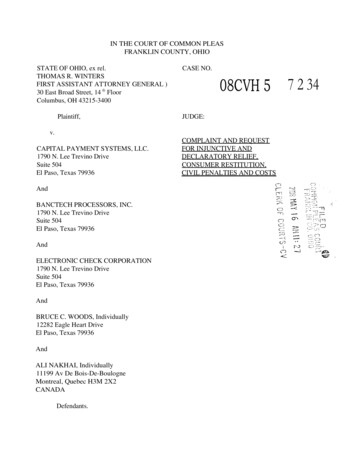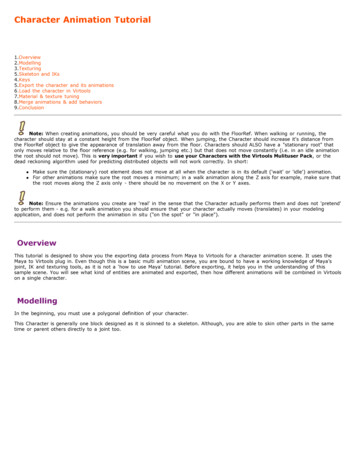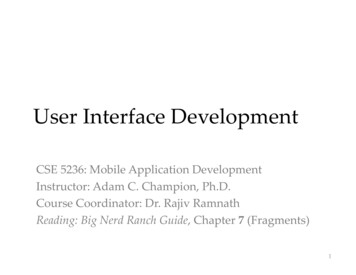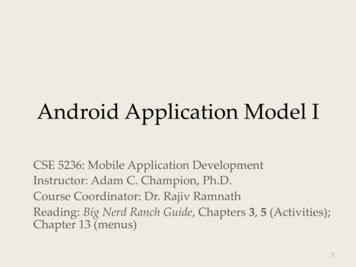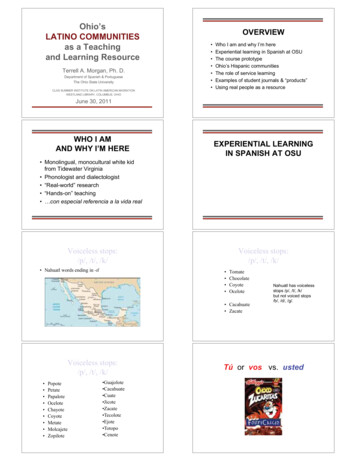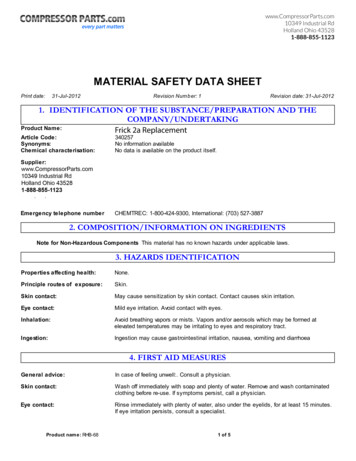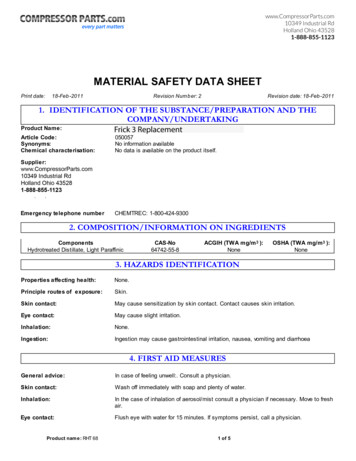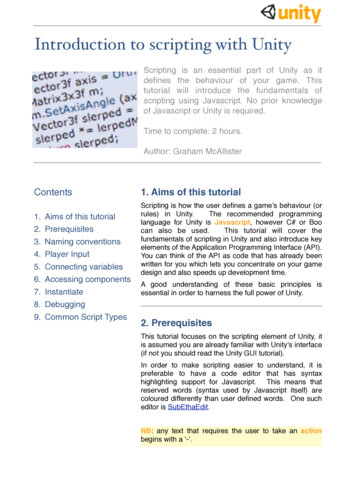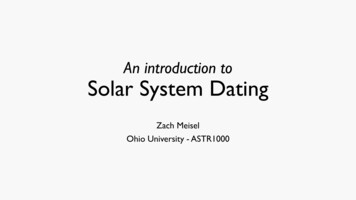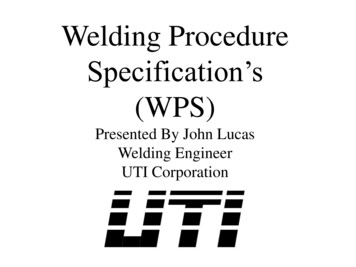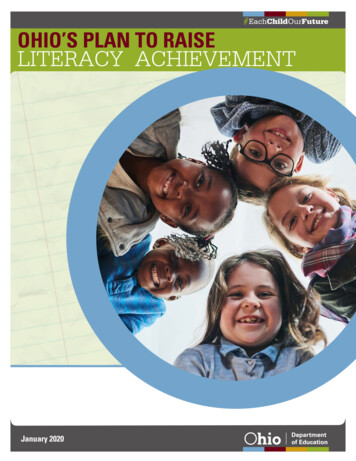
Transcription
EachChildOurFutureOHIO’S PLAN TO RAISELITERACY ACHIEVEMENTJanuary 2020
EachChildOurFutureAcknowledgmentsOHIO’S PLAN TO RAISE LITERACY ACHIEVEMENT is not stagnant and is designed to be a working document to meet state, regional,and local needs for supporting language and literacy development. Ohio’s State Literacy Team assembled in June 2017 to developthe state’s vision and direction for literacy. This team came together again in June 2019 to reflect on two years of development andimplementation and provide additional recommendations for accelerating the progress of this work.The individuals and organizations recognized on the following pages were critical in developing and updating the plan.2019 State Literacy TeamAmy Allen, Ph.D., Transformational Leader of Early Childhood and Special Education, Toledo Public SchoolsKrista Allison, Consultant, Stark Education PartnershipMelissa Babcock, Literacy Specialist, Ohio Department of EducationChristy Ballman, Reading Specialist, Cincinnati Public SchoolsMarcia Barnhart, Literacy Specialist, Ohio Department of EducationShawna Benson, Program Director, Ohio Center for Autism and Low IncidenceKimberly Bell, STEM Program Specialist, Ohio Department of EducationMarcy Berns, Reading Specialist, Cincinnati Public SchoolsMarilyn Brigati, State Support Team Consultant, Region 10Tracey Chestnut, Bureau Chief, Child Care Policy and Technical Assistance, Ohio Department of Job and Family ServicesRachel Lang Daniels, Adolescent Literacy Specialist, State Support Team 11Kimberly Davis, Literacy Specialist, Ohio Department of EducationElizabeth Dawson, Chief Operating Officer, American Academy of Pediatrics, Ohio ChapterJack Cunningham, Principal, East Liverpool City SchoolsJennifer Govender, Outreach Specialist, The Outreach Center for Deafness and BlindnessDebbie Hartwig, State Personnel Development Grant Literacy Lead, State Support Team 9Elizabeth Hess, J.D., Literacy Specialist, Ohio Department of EducationErin Hedges, Speech-Language Pathologist, Cincinnati Public SchoolsRoger Howard, Adolescent Literacy Specialist, State Support Team 3Karen Jeffries, Literacy Specialist, Ohio Department of EducationLaura Jones, Regional Early Literacy Specialist, State Support Team 10Cara Lee, Child Care Policy Supervisor, Ohio Department of Job and Family ServicesKelli Lanzot, Early Intervention Specialist, Department of Developmental DisabilitiesJennifer Lewis, Literacy Coach, Fairfield City SchoolsBobbi Lohiser, Library/Media Center, Pickerington City SchoolsBob Longworth, Superintendent, Lockland Local SchoolsBrie Lusheck, Assistant Director of Children’s Initiatives, Office of Ohio Governor Mike DeWineSarah McClusky, Assistant Director, Ohio Department of Education2 Ohio’s Plan to Raise Literacy Achievement January 2020
EachChildOurFutureSusan Nolan, Ph.D., F/AOGPE, Ohio UniversityNancy Osko, Regional Early Literacy Specialist, State Support Team 2Kelli Perrin, English Learner Specialist, Hamilton County Educational Service CenterTeresa Purses, Ed.D., President, Stark Education PartnershipChris Rauscher, Ph.D., Senior Technical Assistance, American Institutes of ResearchDan Reynolds, Ph.D., Assistant Professor of Literacy Education, Department of Education and School Psychology, John Carroll UniversityElizabeth Sailor-Agnew, Education Program Specialist, Ohio Department of EducationMargo Shipp, Regional Early Literacy Specialist, State Support Team 6Lindsay Slater, Coordinator, State Support Team 3Jan Strahm, Preschool Director, Hamilton Local SchoolsJennifer Walls, 6th Grade Teacher, Riverside Local SchoolsElizabeth Walsh-Moorman, Assistant Professor of Literacy, Lake Erie CollegeRichelle Wardell, Program Officer, Sisters of Charity Foundation of CantonDana Weber, English Learners Consultant, Stark County Educational Service CenterMelissa Weber-Mayrer, Ph.D., Director, Ohio Department of EducationAbby White, Teacher for the Deaf and Hard of Hearing, Ross County Board of Developmental DisabilitiesBlythe Wood, Academic/Behavior Coach Special Education K-12, Pickerington City SchoolsIndividual ContributorsThe following individual contributors provided significant writing and feedback on the plan during various stages of drafting andrevision:Melissa Weber-Mayrer, Ph.D., Ohio Department of EducationSarah McClusky, Ed.D, Ohio Department of EducationElizabeth Hess, J.D., Ohio Department of EducationMelissa Babcock, Ohio Department of EducationKimberly Davis, Ohio Department of EducationHeather Boughton, Ph.D., Ohio Department of EducationAshley Rector, Ph.D., Ohio Department of EducationShawna Benson, Ohio Center for Autism and Low IncidenceJennifer Govender, The Outreach Center for Deafness and BlindnessDana Weber, Stark County Educational Service CenterMichelle Elia, State Support Team 5Laura Jones, State Support Team 10Mary Brooks, State Support Team 10Carolyn Turner, State Support Team 133 Ohio’s Plan to Raise Literacy Achievement January 2020
EachChildOurFutureIntroductionLiteracy skills lay the foundation upon which every individual’s education rests. When a learner receives the necessary tools to developstrong language and literacy skills, he or she becomes able to achieve personal autonomy and pursue aspirations. Ohio is committed tosupporting an education system that prioritizes the language and literacy development of all learners in keeping with its overarchingstrategic plan for education, Each Child, Our Future. That plan promotes the importance of early learning and expanding access toquality early learning experiences. Further, it calls for Ohio and its schools to develop literacy skills in all age groups, grades andsubjects.Ohio’s Plan to Raise Literacy Achievement serves as a guide to evidence-based language and literacy teaching and learning forall learners from birth through grade 12. Acquiring language and literacy skills affects learners’ access to, and interest in, contentmaterials and instruction at all grade levels and all aspects of their lives. Thus, Ohio does not treat language and literacy as a separatefield of study or course, but layers them over all aspects of education. It is critical that every educator and educational activity promotelanguage and literacy development.This plan articulates a state literacy framework aimed at promoting proficiency in reading, writing and communication for all learners. Itis driven by scientific research and encourages a professional movement toward implementing data-based, differentiated and evidencebased practices in all manners of educational settings. Specifically, this plan illustrates the strong language and literacy efforts in placein Ohio and the state’s vision to expand and strengthen them to support improvement.In 2012, Ohio established a literacy development framework under the state’s Striving Readers State Literacy Plan: Reading into theFuture. This plan outlined a comprehensive systems approach to ensuring reading achievement. In 2017, Ohio convened a State LiteracyTeam comprised of birth through grade 12 stakeholders involved with birth through grade 12 literacy. The Ohio Department of Educationasked its members, who have unique expertise in language and literacy content, assessment, instruction, intervention, district and stateprofessional learning design and program evaluation, to develop an updated state literacy plan. The team recommended expanding theexisting State Systemic Improvement Plan (Ohio’s Early Literacy Plan) and capitalizing on Ohio’s regional support system. The group’srecommendation to align state, regional and local efforts for language and literacy development for all learners led to Ohio’s Plan toRaise Literacy Achievement published in January 2018.The State Literacy Team reconvened in June 2019 to reflect on the initial implementation of Ohio’s Plan to Raise Literacy Achievement,analyze updated state data and offer recommendations to enhance the plan. Recommendations include the following revisions: Focus on the need for differentiated core instruction across a multi-tiered system of supportsthat aligns to the science of reading;Integrate Ohio’s K-12 Social and Emotional Learning Standards;Promote collaboration among educators, such as content area teachers and interventionspecialists; andEnhance the graphics and visualizations used throughout the document to help bridge the gapbetween research, education jargon and instructional practice.The updates to Ohio’s Plan to Raise Literacy Achievement are based on these recommendations, as well conversations and resourcesshared during the State Literacy Team convening. The team will continue meeting to review and analyze state, regional and localprogress and revise the plan as needed to meet the needs of Ohio’s diverse learners.4 Ohio’s Plan to Raise Literacy Achievement January 2020
EachChildOurFutureThis plan is not stagnant and is a place to begin exploring dispositions and knowledge. One of the Department’s goals for the plan isto inspire educators to dig deeper, seeking opportunities to grow their knowledge, abilities and skills in the science of reading.This plan is organized into eight sections:1. Ohio’s Theory of Action2. Alignment of Ohio’s Literacy Improvement Efforts3. Why a State Comprehensive Literacy Plan is Needed4. Ohio’s Literacy Vision5. Objectives, Strategies and Activities6. Measuring Success7. Ohio’s Plan for Monitoring Progress8. Implementing Evidence-Based PracticesThe eight sections are modeled after Ohio’s Local Literacy Plan template. The local literacy plan is developed by early childhoodeducation programs and local education agencies working to raise learner performance in literacy. By organizing Ohio’s Plan to RaiseLiteracy Achievement this way, the Ohio Department of Education strives to encourage and help districts, community schools and earlychildhood education programs develop local plans that align to the state’s plan and meet local needs.5 Ohio’s Plan to Raise Literacy Achievement January 2020
EachChildOurFutureSection 1: Ohio’s Theory of ActionEducatorCapacityMulti-TieredSystem Grade 12Language andLiteracy DevelopmentCommunityCollaborationFigure 1: Ohio’s Theory of ActionOhio’s state, regional and local leaders agree that more must be done to ensure all learners have access to high-quality language andliteracy instruction and appropriate intervention, from birth through grade 12. Ohio’s Plan to Raise Literacy Achievement aligns with andbuilds on the state’s current literacy-related policies and practices (see page 7) and promotes evidence-based language and literacyinstruction and intervention. To achieve this alignment, the state is coordinating and linking efforts through the following strands ofaction (see Figure 1).These strands include: Shared leadership;Multi-tiered system of supports;Educator capacity;Family partnerships; andCommunity collaboration.Shared LeadershipStrong leadership gives vision, energy and direction to literacy improvement efforts. Shared leadership means the responsibility forleading and supporting the successful implementation of evidence-based strategies belongs to district leaders, building administratorsand classroom teachers. Sharing leadership is critical to implementing evidence-based instruction and intervention. This means that alleducators are involved in the identification of the challenge, causes of underperformance, solutions to be implemented and performingleadership tasks that support the improvement approach.This is accomplished through structures such as leadership teams (district leadership teams, building leadership teams and teacherbased teams) described in the Ohio Improvement Process. These teams share accountability for data-driven strategic planning,implementation, feedback and plan adjustment. Ohio’s Plan to Raise Literacy Achievement addresses shared leadership through trainingand coaching on evidence-based language and literacy practices and systems to support literacy improvement. This includes targetedtraining and resources for state and regional staff, administrators, principals, instructional coaches and teacher-leaders.6 Ohio’s Plan to Raise Literacy Achievement January 2020
EachChildOurFutureOhio’s Multi-Tiered System of SupportsThe multi-tiered system of supports structure provides a framework for supporting learners based on their unique needs. It can guidestaff in designing effective instruction and appropriate interventions as part of school improvement efforts. A multi-tiered systemof supports for reading includes full access to grade-level instruction for all learners that is differentiated and designed to meet theneeds of all learners (Tier 1) and additional targeted (Tier 2) and/or intensive intervention (Tier 3) for learners experiencing difficulties.The purpose of the three-tier model of instruction is to provide effective core instruction and address reading difficulties as quickly aspossible. Under this model, each tier adds a level of intensity that is designed to accelerate the learner’s rate of learning and avoidlearners requiring intervention for multiple years (Kilpatrick, 2015). As a learner responds positively to the instruction, the intensity isgradually faded. The movement within the tiers of instruction is fluid and data-based, and the tiers represent instruction and supports,not categories of students.Such a system includes a continuum of evidence-based, systemwide practices to address academic and behavioral needs. It alsocalls for frequent, data-based monitoring to inform instructional decision-making to empower each learner to achieve high standards(Sansosti & Noltemeyer, 2008; Shores & Chester, 2008). A multi-tiered system of supports can be used at local, regional and statelevels to address the varied, often complex needs of learners (Hayes & Lillenstein, 2015). Ohio’s Plan to Raise Literacy Achievementincludes training and coaching for state, regional, district and school teams in screening, progress monitoring, instructional decisionmaking (including Universal Design for Learning) and communicating with families within a multi-tiered system of supports.Educator Capacity to Provide Instruction Aligned to the Science of ReadingEducators and quality instruction are the most fundamental components to student acquisition of literacy skills and knowledge.Professional development and technical assistance tied to evidence-based language and literacy development and instructionalpractices are key to building the capacity of teachers to maximize their impact. Ohio is building educator capacity through embedded,sustained professional development and coaching that focuses on evidence-based language and literacy practices and interventions.Ohio’s Plan to Raise Literacy Achievement emphasizes the need for professional learning and resources that deepen educators’understanding of how children learn to read, diagnose why some children struggle to read, and sharpen educators’ abilities toimplement reading instruction and intervention that is aligned to the science of reading and culturally responsive. Much of theprofessional development supports teachers already serving in the classroom. The Department also is partnering with the OhioDepartment of Higher Education and colleges and universities to enhance these areas in teacher preparation programs.[A] key element of teacher qualityis the specialized knowledgeteachers utilize when teaching.- Piasta, 20097 Ohio’s Plan to Raise Literacy Achievement January 2020
EachChildOurFutureFamily PartnershipsFamily partnerships are essential to support learner progress and achievement in language and literacy development. Ohio’s workfocuses on the importance of building these partnerships in early childhood and kindergarten through grade 12 educational settings.Ohio’s Plan to Raise Literacy Achievement emphasizes how state, regional and local educational entities can develop goals andstrategies for supporting families in their critical roles in children’s literacy development. The skills of phonological awareness, letterrecognition, phonemic awareness, oral language, vocabulary, comprehension, motivation and the connection of reading materialto everyday life begin developing at birth. Families play an important role in promoting them. Schools’ strategies for partneringwith families must support the adult behaviors that directly support the language and literacy skills development of children. Bycommunicating with families, offering resources and guidance for literacy development at home, and developing strategic familypartnerships, schools can create holistic and sustainable support systems for learners from birth through graduation. Language andliteracy support for families offered by schools and communities should: Provide all families opportunities to be active supporters of their children’s language and literacy development;Promote language and literacy interactions at home that are enjoyable for children and families;Provide clear, timely understanding for families about their children’s progress;Equip families with the developmentally appropriate strategies and resources they need to support their children’s learning, suchas access to books; Promote literacy in families’ home languages; Incorporate the interests and cultures of children and their families; and Communicate high learning expectations for all children (Boone, et. al., 2017; Caspe & Lopez, 2017; Richards-Tutor, et. al., 2016).Community CollaborationThe final component of Ohio’s Theory of Action is community collaboration. Everyone in the community can contribute to children’sliteracy development. Community partners interested in the healthy development of children are essential, such as libraries, afterschool programs, cultural institutions, health care providers, businesses, philanthropy and the faith-based community. There must be ashared understanding and mutual reinforcement of efforts in their approach to developing children’s reading skills. State-, regional- andlocal-level partnerships help drive literacy improvement and keep in focus why proficient literacy skills are critical. These partnershipsinclude networks that share successes and challenges, provide opportunities to problem-solve and time to consult with each other tostrengthen local literacy plans and community improvement efforts.Section 2: Alignment of Ohio’s Literacy Improvement EffortsOhio’s Language and Literacy DriversOhio’s vision is that each child is challenged to discover and learn, prepared to pursue a fulfilling post-high school path and empoweredto become a resilient, lifelong learner who contributes to society (Each Child, Our Future, 2018). There may be no greater purpose foran education system than to provide all learners with effective evidence-based instruction to build language and literacy knowledgeand skills so they can enjoy full lives of learning and success. Ohio maintains a portfolio of aligned policies and practices aimed atensuring all learners acquire essential literacy skills. The Department promotes alignment of all school improvement efforts into onecomprehensive plan. Clear alignment of local literacy plans to other improvement activities and local improvement efforts is critical.Ohio’s portfolio includes a variety of funding sources, practices, legislation and other policy drivers.8 Ohio’s Plan to Raise Literacy Achievement January 2020
EachChildOurFutureOhio’s Learning StandardsOhio has developed high-quality learning standards aligned across grades that define what learners should know and be able to do.These include: Early Learning and Development Standards (birth to kindergarten entry); Ohio’s Learning Standards (kindergarten-grade 12, including standards for literacy in history and social studies, science andtechnical subjects for grades 6-12); Ohio English Language Proficiency Standards; Ohio’s Learning Standards Extended for learners with significant cognitive disabilities; and Ohio’s K-12 Social and Emotional Learning Standards.System of AssessmentsOhio has developed a standards-aligned system of assessments that measures language and literacy development and outcomes usingthe following: Early Learning Assessment for preschool-age children;Kindergarten Readiness Assessment for learners entering kindergarten;K-3 reading diagnostic assessments used to screen students in kindergarten-grade 3 for reading difficulties;Ohio’s State Tests in English Language Arts for grades 3-8; andHigh school end-of-course exams in English language arts.Accountability System and Report CardsOhio has an accountability system and report cards that describe academic performance through student growth and achievementdata. Ohio School Report Cards include information about student accomplishment in English language arts in grades 3-8 and highschool. Student performance on assessments appears in the Achievement, Progress and Gap Closing components of the report cards.The Improving At-Risk K-3 Readers component also shines light on proficiency rates and improvement among the youngest strugglingreaders.Ohio Improvement ProcessThe Ohio Improvement Process supports focused school improvement. The improvement process advances the state’s ReadingAchievement Plans and local literacy plans to help districts identify learner needs, identify root causes, set goals, develop action plansand monitor continuous improvement.Strong Regional System of SupportsOhio has a strong system of support for districts and schools that includes 16 regional state support teams. Each state support teamhas at least one early literacy specialist, in addition to early childhood and school improvement consultants. Early literacy specialistsprovide support and deliver literacy improvement professional learning to districts across the state. In addition, 52 educational servicecenters support literacy improvement, planning and implementation.Quality PreschoolOhio’s Step Up To Quality rating system ensures all publicly funded, birth to age 5 preschool and child care programs provide effectivesupport for learning and development. Step Up To Quality requires programs to implement ongoing screening and assessments tomonitor children’s learning and development across Ohio’s standards, including language and literacy. In programs rated highest in StepUp To Quality, early childhood educators use assessment results to inform improvements to individual instruction.9 Ohio’s Plan to Raise Literacy Achievement January 2020
EachChildOurFutureOhio’s Third Grade Reading GuaranteeTo promote the mastery of age-appropriate reading skills at the earliest stages of a child’s academic experience, Ohio enacted theThird Grade Reading Guarantee in 2012. This law requires all districts and schools to screen all K-3 students to determine whetherthey are on track or not on track to read on grade level. Each learner identified as a struggling reader is required to receive a ReadingImprovement and Monitoring Plan to individualize reading instruction based on the learner’s identified needs. The services providedthrough these plans must be grounded in scientific evidence to ensure progress toward proficient reading. As part of Ohio’s Plan toRaise Literacy Achievement, the Department is updating guidance and resources associated with these plans to reflect the latestresearch on reading difficulties.Ohio’s Dyslexia Pilot ProjectOhio’s Dyslexia Pilot Project (2012-2015) involved eight school districts. The goals of the pilot project were to evaluate (a) theeffectiveness of early screening and reading assistance programs for children at risk for reading failure; and (b) whether those programscould reduce future special education costs. The pilot’s external evaluator found a cost savings attributable to the pilot. All participatingschool districts that met the requirements for the project in Year 3 demonstrated meaningful gains in learner rates of improvement thatare likely to be sustainable. Ohio projects that, over time, all school districts will experience special education cost savings exceedingthe initial pilot investment (Morrison, 2015). Several of the practices tested in Ohio’s Dyslexia Pilot Project were included in Ohio’s EarlyLiteracy Pilot (see below) to test their scalability and sustainability.Ohio’s State Systemic Improvement Plan: Early LiteracyOhio’s Early Literacy PlanStakeholders from across the state helped develop Ohio’s Early Literacy Plan using the active implementation framework (Fixsen et al.,2013; National Implementation Research Network, 2013). To develop the goals and strategies that formed the basis for Ohio’s Theory ofAction (Appendix B), the stakeholder group analyzed the framework’s drivers, which included competency, organization and leadership.Stakeholders reviewed the results of Ohio’s Dyslexia Pilot Project to identify critical supports Ohio would need to provide for schoolstaking part in the Early Literacy Pilot.Ohio’s Early Literacy PilotOhio’s Early Literacy Pilot supports educators and leaders implementing evidence-based language and literacy strategies as part oftheir instruction and interventions. It involves two cohorts in 15 high-needs districts. Implementation includes professional learningin the science of reading, instructional and systems coaching, family engagement and use of data to inform instruction. The pilotserves as the foundation for the design and implementation of evidence-based strategies contained in Ohio’s Plan to Raise LiteracyAchievement. Ohio’s Early Literacy Pilot is undergoing an independent evaluation by an external evaluator. That evaluation is informingprekindergarten-grade 5 improvement efforts and the development of a statewide professional learning plan for educators servinglearners from birth to grade 12.Ohio’s State Personnel Development GrantOhio currently is implementing its third State Personnel Development Grant. This grant aims to scale and sustain strategies testedthrough Ohio’s Early Literacy Pilot. The current grant brings together three concepts:1. Professional learning targeting recent research on language and literacy core instruction and interventions;2. Advances in understanding of implementation research to further develop educators’ competencies; and3. A systemic approach to build capacity and increase sustainability beyond the life of the project.Guide for Ohio’s Goals and ObjectivesTaken together, the above portfolio of policies and practices drives Ohio’s commitment to improving literacy outcomes for all learners.State leaders will continue to ensure these efforts align with the goals and objectives of Ohio’s Plan to Raise Literacy Achievement(described in Section 5), as well as other school improvement efforts. This portfolio will continue to expand as the Department annuallyexamines data and identifies targets for improvement.10 Ohio’s Plan to Raise Literacy Achievement January 2020
EachChildOurFutureSection 3: Why a State Comprehensive Literacy Plan is NeededThis section summarizes Ohio’s comprehensive needs assessment. This assessment focuses first on learner performance data, then ona root cause analysis and ends with data and recommendations from the external evaluation of Ohio’s Early Literacy Pilot. This analysisillustrates the critical need for explicit support for implementing evidence-based language and literacy instruction and intervention toimprove learning outcomes, not only in the classroom but across the educational system (state, regional, district-school, grade levels,classrooms, family and community).In June 2019, Ohio’s State Literacy Team examined selected 2018 school-year data from birth through grade 12 to update the state’scomprehensive needs assessment.2018 Learner Performance DataFrom birth, many of Ohio’s students face challenges to achieving their full educational potential. Consider the following about Ohiochildren: One-fourth of all Ohio children under age 6 live in poverty, and one-half are in families living below 200 percent of theFederal Poverty Level (Ohio Poverty Report, 2017); Young children represent one of the fastest growing segments of Ohio’s homeless population (Ohio Housing FinanceAuthority, Revisiting the Silent Crisis, 2018); The number of children in the custody of Ohio’s children services agencies has been rising since 2010. More than 15,000children were in custody in 2018 and 39 percent of those were under the age of 5 (Public Children Services Associationof Ohio, 2019);The societal challenges Ohio’s students face can be seen through inequities in educational outcomes and are exacerbated by inequitiesin access to high-quality education.Literacy inequities are visible statewide, but they are felt even more keenly in schools serving students from economicallydisadvantaged backgrounds, referred to as “high-needs schools.” In 2018, almost half (48.4 percent or 1,616) of Ohio’s elementary, middle and high schools were high-needs schools (asdefined by the U.S. Department of Education), serving more than 720,000 (43.9 percent) of Ohio’s students; While about one-third (32.95 percent) of white, non-Hispanic students attended high-needs schools, 83.4 percentof black students, 61.3 percent of Hispanic students, 50 percent of American Indian students and 56.4 percent ofmultiracial students attended high-needs schools in 2018; and A strong majority (70.2 percent) of English learners attended high-needs schools in 2018.11 Ohio’s Plan to Raise Literacy Achievement January 2020
EachChildOurFutureBirth Through Kindergarten EntryChildren in high-quality rated early childhood education programs perform significantly better on Ohio’s Kindergarten ReadinessAssessment than their peers, specifically on language and literacy (Compass Evaluation and Research, 2017). There continues to be aneed to reach more students with quality early education programs and quali
Section 1: Ohio’s Theory of Action Figure 1: Ohio’s Theory of Action Ohio’s state, regional and local leaders agree that more must be done to ensure all learners have access to high-quality language and literacy instruction and appropriate intervention, from birth through grade 12. Ohio’s Plan to Ra

